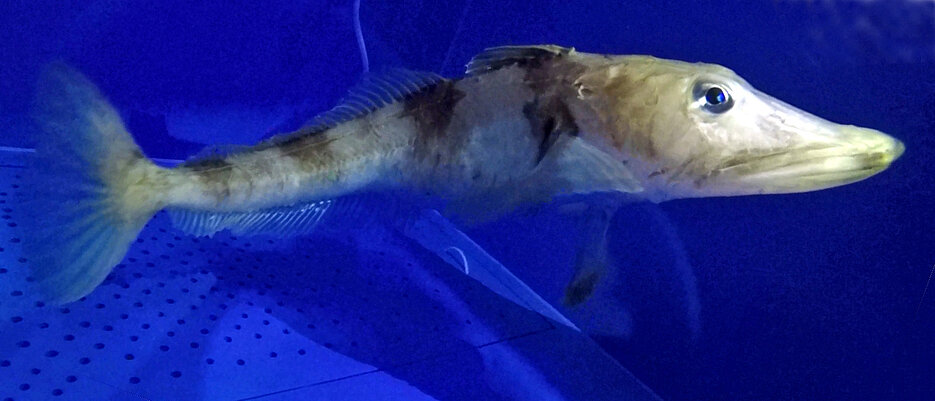Cool adaptations to the cold
02/25/2019Icefish live in an environment that should be deadly for them. Scientists have now investigated how they still manage to exist there and what evolutionary adaptations they have had to undergo in order to do so.

You really don't want to have to live there: In the Arctic Ocean around the South Pole, the water temperature is just below minus two degrees. Humans would have no chance of survival there, and it is also too cold for most fish species: their blood would simply freeze, ice crystals would burst their red blood cells - the erythrocytes. But yet there is one species of fish that even feels at home under such hostile conditions and that reproduces there: the so-called icefish from the Nototheniidae family.
An international team of scientists has now investigated which genetic adaptations are responsible for the survival of ice fish atextreme cold, and has come across a number of characteristic changes. The geneticist Manfred Schartl, head of the Department of Physiological Chemistry at the Julius Maximilians University of Würzburg (JMU), was involved in this project. In the current issue of the journal Nature Ecology & Evolution, the researchers present the results of their investigations.
Living at minus temperatures
In their study, Manfred Schartl and Hyun Park together with John Postlethwait, who worked with a Humboldt Prize at the JMU Biocenter in 2009, and other researchers from Korea and the USA, sequenced the genome of the Antarctic blackfin icefish, Chaenocephalus aceratus, and searched for specific changes that are responsible its unique physiology. They also gained insights into the evolution of this fish . "Ice fish populations first appeared at the end of the Pliocene after Antarctica’s surface temperatures dropped by 2.5 degrees Celsius," explains Schartl. About 77 million years ago, they had diverged from the line of their common ancestors with the sticklebacks - and then developed phenotypes that were better adapted to the cold.
The ancestral Nototheniids were red-blooded, but had no oxygen-binding proteins, so-called myoglobins, in their skeletal muscle. In addition, they lived on the seabed and had no buoyancy-generating swim bladder. When Antarctica cooled down and finally reached temperatures of just below minus two degrees Celsius about ten to 14 million years ago, new ecological niches opened up that ice fish could occupy thanks to special adaptations. Eight fish species from the Notothenioid family, including ice-fish, also took the opportunity of the advantageous food supply at higher altitudes - away from the seabed.
Blood without red blood cells
It is a combination of several factors that enables icefish to survive in extreme cold. The most conspicuous of these: The animals lack the red blood cells - and therefore haemoglobin; their blood is therefore virtually transparent. Manfred Schartl explains that they nevertheless do not suffer from oxygen deprivation: "At low temperatures, the oxygen saturation of the sea water and thus also of all body fluids of the fish is so high that oxygen transport through the supporter molecule haemoglobin is no longer necessary". At the same time, the blood volume of icefish is twice as large as that of comparable fish species living at more moderate temperates, their heart is enlarged and their blood vessels also have a larger diameter. The number of the energy suppliers of the cells - the mitchondria - is also increased in icefish.
Another evolutionary achievement of this genus enables survival at sub-zero temperatures: Icefish produce special proteins that protect them from cold death. While antifreeze glycoproteins in fish larvae and adult animals prevent ice formation in the body, ice-resistant egg chorion or zona pellucida proteins surround embryos and protect them from freezing.
Significant changes in the genome
All these changes have left clearly visible traces in the genome of ice fish: “Our results show that the number of genes involved in the protection against ice damage, including the genes coding for anti-freeze glycoproteins, is strongly expanded in the icefish genome," explains Manfred Schartl. The high oxygen concentration both in the cold Antarctic waters and in the bodies of the ice fish has also led to adaptations in the genome. Since oxygen radicals can cause cell damage, the animals possess many genes for enzymes that help to protect from such damage.
At another region in the icefish genome, the scientists discovered changes that can be associated with their demanding habitat: they lack some important regulators that control the day-night rhythm in other animal species. The researchers suspect that the extremes of the almost permanent nights of winter darkness and the long days of the Antarctic summers may have reduced the usefulness of some of these regulators and thus the evolutionary pressure to retain them. However, to finally answer this question, behavioural studies on Antarctic icefish and other related species are necessary.
An evolutionary model for human diseases
Their special features make icefish interesting for biomedical research. "Under natural conditions, they have developed phenotypes that correspond to human diseases," says Manfred Schartl. For example, the absence of erythrocytes is tantamount to complete anaemia. In addition, the fish have given up bone calcification in the course of their evolution in order to reduce their body density. This had become necessary in order to be able to detach themselves from the seabed and swim in open water again. In order to do this, they had to reduce their body weight by not mineralizing their bones. These are therefore in a condition similar to that found in osteoporosis patients.
Antarctic blackfin icefish genome reveals adaptations to extreme environments. Bo-Mi Kim, Angel Amores, Seunghyun Kang, Do-Hwan Ahn, Jin-Hyoung Kim, Il-Chan Kim, Jun Hyuck Lee, Sung Gu Lee, Hyoungseok Lee, Jungeun Lee, Han-Woo Kim, Thomas Desvignes, Peter Batzel, Jason Sydes, Tom Titus, Catherine Wilson, Julian M. Catchen, Wesley C. Warren, Manfred Schartl, H. William Detrich III, John H. Postlethwait and Hyun Park. Nature Ecology & Evolution, https://doi.org/10.1038/s41559-019-0812-7
Contact
Prof. Dr. Manfred Schartl, T: 49 931 31-84149, phch1@biozentrum.uni-wuerzburg.de









